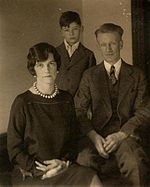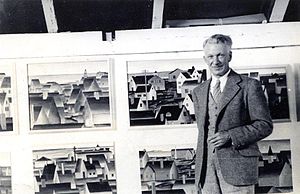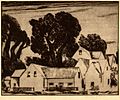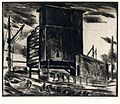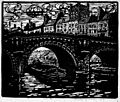- Charles James Martin (artist)
-
Charles James Martin 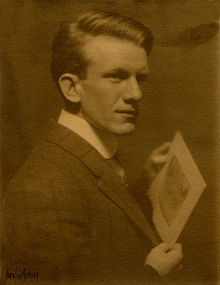
Charles James Martin, photographed by Caroline Geiger, circa 1910.Born September , 1886
Mansfield,
EnglandDied August 9, 1955 (aged 68)
Hyannis, Massachusetts,
United StatesNationality American Field Painting Charles James Martin (September 1886 – August 9, 1955) was an American modernist artist and arts instructor. He worked in a variety of media including etching, lithography, water color, monotype, linocut, woodcut, oil, photography, mezzotint and silversmithing. Born in Mansfield, England in 1886, Martin emigrated to the USA as a boy and lived out the remainder of his life as an American. He studied art under Arthur Wesley Dow at Dow’s Ipswich Summer School of Art as well as at Columbia University Teachers College, where he became an instructor himself in 1914.
Mr. Martin's work is after the new modernist school, the art that seeks essence rather than form, interpretation rather than faithful representation. The results of this first year's training in a type of work so entirely new to Teachers College students are highly gratifying to Professor Dow. According to Mr. Martin, modernist painting must be preceded by ordinary symmetrical drawing by the student. In other words, rules must be learned before they can be departed from. The exhibit showed, therefore, not only paintings of this new character, but also drawings of the old style,—symmetrical, detailed, precise. One of the color experiments of particular interest in this interpretative painting is that of “optical mixtures,” a process by which the mixing of colors to produce another color, is left to the eye, rather than mixed on the palette; green foliage, for example, may be represented by intermingling splotches of blue and yellow. The exhibit showed these modernist studies done in all mediums, —oil, chalk, tempora, water color.[1]
Martin attained professorship at Teachers College in 1923[2] and continued his work there into the 1940s. Georgia O’Keeffe attended Martin’s class at Teachers college in 1914-15, where she met Anita Pollitzer. O’Keeffe considered Martin’s instruction significant enough that she continued sending examples of her work for his critique in the period after she attended his class.[3] Martin even had a fan in Winston Churchill, as a friend of his writes in a letter circa 1930s:
Wednesday afternoon Mr. and Mrs. Winston Churchill and two sons came in for tea; both Mr. and Mrs. C. are crazy about sketching and water colors. Mr. C. went back to [Charles’] picture three times and stood for ages admiring and commenting upon it- thought the light and shadows perfect and loved the simplicity of the theme. I always feel so proud to say “our friend Prof. Martin!"[4]
In the 1910s, Martin also studied photography with Clarence H. White at Teachers College, and became an instructor at White’s School of Photography in 1918.[5] Also in 1918, Martin won first prize in a photography contest held by Columbia University in which Dow and White were judges.[6] During this time period, he also served on the Executive Committee of the Pictorial Photographers of America [3].
Martin spent many summers in the 1920s-50s living and teaching plein air art classes in Provincetown, Mass,[7] and also in Mexico.[8] Martin continued working as an art instructor, often on a freelance basis, for the remainder of his life. He died on August 9, 1955 in Hyannis, MA, after a short illness. He is buried at North Burial Ground, Providence, Rhode Island.[9]
Contents
Personal life
At Teachers College, Martin met a fellow art student named Esther L. Upton, whom he eventually married. Upton was the niece of Clifford B. Upton and Siegried M. Upton, both prominent instructors at Teachers College and also the affiliated Horace Mann School. (Mrs. Upton was also an accomplished photographer who studied with Clarence H. White.) Charles and Esther lived for a brief time in Paris, France in 1913-14. In 1918 they gave birth to their only child, James Upton "Kimo" Martin (b. May 16, 1918, d. Jan 20, 2007)[4]. Charles and Esther eventually separated, and spent most of the 1920s onward living far apart from each other. James spent time living with both of his parents. He grew up to become an accomplished artist and furniture designer in his own right.
Selected Exhibitions and Reviews
- American Water Color Society Exhibition, National Arts Club, 1916
There are two “Interiors” in the exhibition which provide contrast and text. One shall be nameless[...] The other is a picture by Charles J. Martin in the alcove. Mr. Martin has approached his subject first of all in the spirit of an artist with analyses to make. He has taken the haphazard of nature and reduced it to orderly plan. Or to speak more truly, he has taken the fragment of nature that presented itself to him at some one moment and recreated it until by virtue of art it became a whole, an organism, in which every part is essential to the others. He has seen his room as a pattern in which the black stove with its aggressive pipe is balanced by a black chair or something, and beautiful bright threads of color run in and out of large neutral patches of violet and dull yellow. A rug designer would see how handsome it is. But the artist in this instance has had also a sense of humor and a conscience, and since his room is a human abode he has analyzed its character and made of his work a witty and penetrating comment. That is what makes it so difficult to forgive. The makers of patterns are not all so successful as Mr. Martin.[10]
- Columbia Teachers College, 1916
Mr. Martin's method makes water color a thing to reckon with at a distance, a medium capable of decorative effect. He pays tribute to the peculiar character of the medium, its sparkling idiosyncrasy, by his use of the white outline, which detaches the masses of color from one another, keeping them in one plane as effectively as the black bounding line in favor with one school of modern painters; and which has the advantage of giving the white ground of the paper a chance to play its enlivening part in the general scheme.[11]
- Philadelphia Water Color Exhibition, 1916[12]
- MacDowell Club Sketch Exhibition, 1917[13]
- Pictorial Photographers of America Exhibition, Detroit Museum of Art, January 4–28, 1918 [5]
- Painter-Gravers Of America Exhibition, 1919[14]
- Provincetown Art Association Exhibition, 1927[15]
- Morton Galleries, New York City, 1929[16]
- International Water Color Exhibition, Art Institute of Chicago, May 2 - June 2, 1929 [6]
- Provincetown Art Association Exhibition, 1931[17]
- Morton Galleries, New York City, 1931
Charles J. Martin, well known for his freedom from academic restraint in his method of teaching design, achieves an equally unhampered expression in his creative work. “The Factory” is a boldly conceived design, especially rich in its use of resonant blacks. In contrast to the rugged construction of this work is the fluent character of the “Sand Pit,” where the harmonic tour de force of combining warm and cold tonalities is skillfully accomplished.[18]
- Morton Galleries, New York City, 1932.[19]
Possibly the most striking paper in the show is the landscape by Charles Martin. Mr. Martin, a professor of painting at Columbia, has an original and powerful technique. He achieves architectonic pattern without any important loss in realism.[20]
- Morton Galleries, New York City, 1933[21]
- Morton Galleries, New York City, 1934[22]
- Delphic Studios, New York City, 1934[23]
- Morton Galleries, New York City, 1936[24]
- Morton Galleries, New York City, 1937[25]
- Morton Galleries, New York City, 1938[26]
- Brooklyn Museum Art School, 1949[27]
Selected Teaching CV
- Columbia University Teachers College (1914-1940s)
- Clarence H. White School of Photography (1918-1920s)
- Art Students’ League (early 1920s)[28]
- Textile Guild of the Keramic Society of Greater New York (early 1920s)[29]
- New York High School (1927 seminars for art instructors)[30]
- Evander Childs High School (1927 seminars for art instructors)[30]
- Skidmore College (1928)[31]
- University of Chicago (1929)[32]
- Eastern Arts Convention, Philadelphia (1940)[33]
- War Veteran’s Art Center, Museum of Modern Art (1940s)[34]
Selected publications
- Notes On Permanent Painting, a 1924 article for Teachers College Record.[35]
- Creative Design In Painting, a 12 minute 16 mm educational film, 1936. "A demonstration of the organization of lines and areas within a rectangle. The illustration of these design principles is then carried over into the painting of a landscape in watercolor."[36]
- How To Make Modern Jewelry[7], New York : Museum of Modern Art : distributed by Simon and Schuster, 1949.
Gallery of Selected Art Works
Notes
- ^ Teachers College Record Volume 16 Number 4, 1915, p. 388-388
- ^ Teachers College Record Volume 24 Number 4, 1923, p. 374-392
- ^ “Living On Paper:” Georgia O'Keeffe and the Culture of Drawing and Watercolor in the Stieglitz Circle [1], Ann Prentice Wagner, Dissertation, 2005, p. 160-161
- ^ Personal letter to Martin’s family, circa 1920s, with illegible signature
- ^ Photos from the Clarence H. White School, online article by Verna Posever Curtis for the Library of Congress [2]
- ^ Teachers College Record Volume 19 Number 2, 1918, p. 215-215
- ^ Teachers College Record Volume 26 Number 10, 1925, p. 881-891
- ^ "New Trend In Art Found In Mexico", New York Times, Dec. 6, 1936
- ^ "Deaths", New York Times, Aug. 11, 1955
- ^ "Water Color Exhibition", New York Times, Feb 5, 1916
- ^ "Teachers College Students Exhibit Their Work", New York Times, May 18, 1916
- ^ From an exhibition label on the back of his painting “An Interior”
- ^ "Art Exhibitions of the Closing Season", New York Times, May 13, 1917
- ^ "Hogarth and Other English Painters", New York Times, March 16, 1919
- ^ "Modern Artists Show Work at Provincetown", New York Times, July 10, 1927
- ^ "A Round Of Galleries", New York Times, March 10, 1929
- ^ Edward Alden Jewell, "Three-Reel Travelogue", New York Times, July 12, 1931
- ^ "New Morton Gallery Opens", New York Times, Oct. 13, 1931.
- ^ "Some Interesting Water-Colors", New York Times, Jan. 20, 1932
- ^ "The Week In New York: A Roster Of New Exhibitions", New York Times, Oct 23, 1932
- ^ Edward Alden Jewell, "Superb Islamic Painting", New York Times, Oct 15, 1933
- ^ Howard DeVree, "Notes On Some Current Exhibitions", New York Times, Oct 7, 1934
- ^ "20 Art Exhibitions To Open This Week", New York Times, Dec. 17, 1934
- ^ Howard DeVree, "A Round Of Galleries", New York Times, March 22, 1936
- ^ Ruth Green Harris, "Landscape vs. Portrait", New York Times, June 13, 1937
- ^ Howard DeVree, "Flames In The Embers", New York Times, July 3, 1938
- ^ "Variety Of Shows Due At Art Salons", New York Times, Feb. 21, 1949
- ^ Teachers College Record Volume 22 Number 5, 1921, p. 433-433
- ^ Teachers College Record Volume 22 Number 5, 1921, p. 433-433
- ^ a b Teachers College Record Volume 28 Number 7, 1927, p. 736-737
- ^ Teachers College Record Volume 29 Number 7, 1928, p. 628-647
- ^ Teachers College Record Volume 31 Number 2, 1929, p. 175-175
- ^ Teachers College Record Volume 41 Number 99, 1940, p. 690-690
- ^ Martin, Charles J. (1949). How To Make Modern Jewelry, New York : Museum of Modern Art : distributed by Simon and Schuster.
- ^ Teachers College Record Volume 25 Number 1, 1924, p. 51- 60
- ^ Educational Film Guide (1951), New York, H. W. Wilson Co
Categories:- 1886 births
- 1955 deaths
- American artists
- American educators
- American printmakers
- Modern artists
Wikimedia Foundation. 2010.

